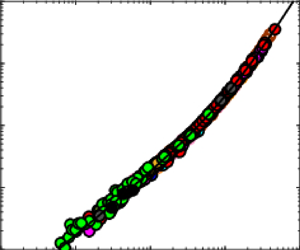Article contents
Scaling laws for planetary sediment transport from DEM-RANS numerical simulations
Published online by Cambridge University Press: 17 May 2023
Abstract

We use an established discrete element method (DEM) Reynolds-averaged Navier–Stokes (RANS)-based numerical model to simulate non-suspended sediment transport across conditions encompassing almost seven orders of magnitude in the particle–fluid density ratio  $s$, ranging from subaqueous transport (
$s$, ranging from subaqueous transport ( $s=2.65$) to aeolian transport in the highly rarefied atmosphere of Pluto (
$s=2.65$) to aeolian transport in the highly rarefied atmosphere of Pluto ( $s=10^7$), whereas previous DEM-based sediment transport studies did not exceed terrestrial aeolian conditions (
$s=10^7$), whereas previous DEM-based sediment transport studies did not exceed terrestrial aeolian conditions ( $s\approx 2000$). Guided by these simulations and by experiments, we semi-empirically derive simple scaling laws for the cessation threshold and rate of equilibrium aeolian transport, both exhibiting a rather unusual
$s\approx 2000$). Guided by these simulations and by experiments, we semi-empirically derive simple scaling laws for the cessation threshold and rate of equilibrium aeolian transport, both exhibiting a rather unusual  $s^{1/3}$-dependence. They constitute a simple means to make predictions of aeolian processes across a large range of planetary conditions. The derivation consists of a first-principle-based proof of the statement that, under relatively mild assumptions, the cessation threshold physics is controlled by only one dimensionless control parameter, rather than two expected from dimensional analysis. Crucially, unlike existing models, this proof does not resort to coarse-graining the particle phase of the aeolian transport layer above the bed surface. From the pool of existing models, only that by Pähtz et al. (J. Geophys. Res.: Earth, vol. 126, 2021, e2020JF005859) is somewhat consistent with the combined numerical and experimental data. It captures the scaling of the cessation threshold and the
$s^{1/3}$-dependence. They constitute a simple means to make predictions of aeolian processes across a large range of planetary conditions. The derivation consists of a first-principle-based proof of the statement that, under relatively mild assumptions, the cessation threshold physics is controlled by only one dimensionless control parameter, rather than two expected from dimensional analysis. Crucially, unlike existing models, this proof does not resort to coarse-graining the particle phase of the aeolian transport layer above the bed surface. From the pool of existing models, only that by Pähtz et al. (J. Geophys. Res.: Earth, vol. 126, 2021, e2020JF005859) is somewhat consistent with the combined numerical and experimental data. It captures the scaling of the cessation threshold and the  $s^{1/3}$-dependence of the transport rate, but fails to capture the latter's superimposed grain size dependence. This hints at a lack of understanding of the transport rate physics and calls for future studies on this issue.
$s^{1/3}$-dependence of the transport rate, but fails to capture the latter's superimposed grain size dependence. This hints at a lack of understanding of the transport rate physics and calls for future studies on this issue.
JFM classification
Information
- Type
- JFM Papers
- Information
- Copyright
- © The Author(s), 2023. Published by Cambridge University Press
References
- 8
- Cited by


